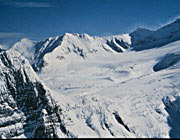 |
 | |
  | |
|
|
|
|
Glacier National Park
Natural Features & Ecosystems
|
|
|
|
|
|
 |
 |
| J. Mohlenrich photo | | Jackson Glacier |
 |
Most people visit Glacier National Park because of its scenery. The combination of vertical, glacier-scoured banded mountains, pristine turquoise lakes and streams, dense ancient forests and an unrivaled assemblage of plants and animals makes superlatives inadequate. Glacier is big, wild, majestic, awesome, and spectacular, but visitors seeing it for the first time -- when their open mouths begin working again -- often say something profound, like "wow".
Glacier Park has glaciers, of course. A few can be seen from roads, tucked into cirque amphitheaters. Their blue ice and crevasses distinguish them from the hundreds of snowfields above timberline. They, and the colored bands of rock striping the mountains, remind us of the park's antiquity, and perhaps our own origins.
Getting behind the scenery requires hiking some of the 747 miles of trails in Glacier. The deeper we walk into Glacier, both literally and figuratively, the more interesting and fascinating it becomes. From putting our noses close to tiny insect-eating sundews in the wetland fens, to beaver-watching at dusk in the east-side aspenlands, to startling as a ptarmigan explodes from an alpine willow thicket, to watching groups of black swifts emerge from their nests at dusk from behind raging waterfalls, the word is still "wow".
Add to that the probability that wolves, cougars, lynx, wolverines, bighorn sheep, mountain goats, elk, moose and grizzly bears watch us from their hidden places most of the time -- sometimes we get to watch them back -- and hair refuses to lie down on our necks.
Glacier's permanent inhabitants probably don't take the park for granted either. Occasionally a Clark's nutcracker, moving from whitebark pine seed-gathering at timberline to one of its thousands of burying spots, goes into a dive down a narrow canyon. It loops at the bottom of the dive and its wings roar. It sounds much like "wow".
In Glacier, that's a sentiment we all share.
|
|

|
 |
|
|
|
|
|
 |
|
Did You Know?
Did you know that some alpine plants can live to be more than a hundred years old, despite living in harsh weather conditions?
|
|
|
|
Last Updated: March 10, 2008 at 11:22 EST |






